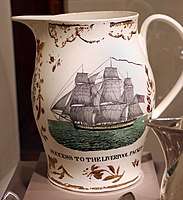Herculaneum Pottery
The Herculaneum Pottery was based in Toxteth, Liverpool, England. between 1793/94 and 1841.[1] They made creamware and pearlware pottery as well as bone china porcelain.
| Wikimedia Commons has media related to Herculaneum Pottery. |
About 1793-4 Richard Abbey, who had been apprenticed to John Sadler, an engraver, started a pottery at Toxteth Park, on the north side of the River Mersey, along with a Scotsman named John Graham.[1] In 1796 they sold the business to Worthington, Humble & Holland, who engaged as manager Ralph Mansfield, of Burslem.[1] He left them after some years' service, and commenced a small pottery on his own account.[1] In addition to Mansfield, the new company engaged about forty men from the Staffordshire potteries, and they were transported there by boat.[1] The buildings acquired from Abbey were considerably enlarged and improved, and as Wedgwood had called his new colony "Etruria", the company christened theirs "Herculaneum".[1]
The first productions were transfer-printed earthenware, which was carefully potted and of a somewhat deeper shade than that of Wedgwood.[1] The company must have done a good trade with America, because there are many pieces bearing American designs and emblems.[1] Some services had the embossed basket rims, and one of these was printed with views of well-known English scenery.[1] Terra-cotta vases and statuettes in black basaltes were also made, as were also jugs with relief figures.[1] In 1800 the manufactory was considerably enlarged, and again in 1806.[1] Early in the 19th century china was produced, and its manufacture was continued to the close of the works.[1]
In 1833 the company was dissolved, and sold for £25,000 ($125,000) to Mr. Ambrose Lace, who leased the premises to Thomas Case and James Mort.[1] They introduced as a trademark the Liver, which is the crest of the borough of Liverpool.[1] In 1836 they were succeeded by Mort & Simpson, who continued until the close of the works in 1841.[1] Early wares were marked "HERCULANEUM".[1]
The company gave its name to the Herculaneum Dock which occupied the site later.[2]
 Creamware basket and stand, c. 1796-1805
Creamware basket and stand, c. 1796-1805 Jug 1880-05 "Success to the Liverpool Packet", which flies an American flag. Inscribed "presentation" wares for ships were a speciality of Liverpool potters.
Jug 1880-05 "Success to the Liverpool Packet", which flies an American flag. Inscribed "presentation" wares for ships were a speciality of Liverpool potters..jpg) Transfer-printed dish, c. 1810
Transfer-printed dish, c. 1810 Imitation jasperware coffeepot, 1800-1810
Imitation jasperware coffeepot, 1800-1810
References
- Jervis, William Percival (1902). The encyclopedia of ceramics. Blanchard. p. 284. OCLC 1026619.

- "IMPORTANT SALE OF THE EXTENSIVE AND VALUABLE STOCK IN TRADE, UTENSILS, AND MATERIALS OF THE HERCULANEUM POTTERY". Newcastle Courant. British Newspaper Archive. 30 October 1840.
Further reading
- Liverpool Herculaneum Pottery, Alan Smith, Barrie & Jenkins, London, 1970
- Hyland, Peter (2005). The Herculaneum Pottery: Liverpool's Forgotten Glory. Liverpool University Press. ISBN 978-0-85323-979-6.